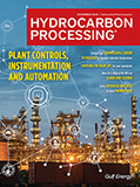Heat Transfer
Steam generator in a hydrocracker high-pressure loop—why not?
Historically, there has been a perception in the industry that it is not safe to include a steam generator in the high-pressure loop of a hydrocracker.
Flow modeling as a tool for WHRU performance optimization
Greenhouse gas (GHG) emissions have become a growing concern for many industrialized countries over the past few years.
Use CFD modeling to improve burner design and operation
Process heaters are essential pieces of equipment in the refining and petrochemical industry that are used to heat hydrocarbons to a desired temperature.
Refinery tower inspections: Discovering problems and preventing malfunctions
A previous survey identified installation mishaps to be one of the top five causes of tower malfunctions.
Water Management: Minimize white rust in galvanized cooling systems
Galvanized coatings for cooling tower systems (cooling towers, evaporator tube bundles, etc.) have been used in the industry since the 1950s due to their relatively low cost and long service life.
Cost-effective naphtha hydrotreating unit revamp to increase high-octane reformate production
India, which is the third-largest economy in the world, is home to nearly 18% of the world’s population (nearly 1.4 B).
Case study: Extend tube life in a waste heat boiler
The sulfur recovery unit (SRU) separates sulfur from sulfur compounds.
Apply ceramic coatings to extend radiant tube life in process heaters
Process tubes in refining applications are typically steel alloy (ASTM A335 P22, P5 or P9), which contain 2.25%, 5% and 9% Cr, respectively. These grades oxidize at operating temperatures, and scale will grow continuously on the surface, often reaching 2 mm in thickness in higher-temperature/high-heat-flux units. The layers of scale are very insulating and represent a significant barrier to conductive heat transfer to the process.
Optimal gas analysis decisions improve ethylene plant operation
One of the most common and important building blocks in the petrochemical industry is ethylene, constituting a huge and fast-growing worldwide industry. Ethylene is an intermediate chemical used to manufacture many commercial products—approximately 200 MMt will be produced in 2020.
Case study: Heat exchanger tube rupture and its impact on metal embrittlement
Process engineers strive to recover as much energy as is practically possible from the available process and utility streams within the constraint of the plant. To achieve this goal, traditional—and sometimes non-traditional—methods are utilized. In a steam cracker, light olefins are considered the highest-value products, and utilizing “cold energy,”

- NAPCOR releases 2024 PET recycling report highlighting system efficiency gains and continued strength of PET circularity 12/12
- OQ courts other partners for petrochemical complex in Oman as SABIC drops out 12/12
- Brazil's BNDES approves $71 MM for carbon storage project 12/12
- Cuba on edge as U.S. seizure of oil tanker puts supply at risk 12/12
- China oil demand to plateau between 2025 and 2030 12/12
- Germany's PCK refinery says no impact from pipeline leak 12/12




